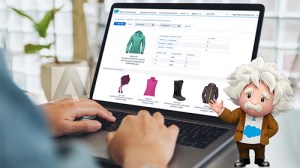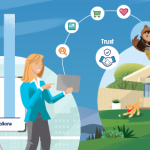With inputs by Sridhar Hariharasubramanian, Senior Director
Customers today expect a lot more from the whole shopping experience than they used to. While they still want quality products, they’re also looking for a seamless and consistent experience that starts long before purchase, and ends long after.
Customers also use multiple channels to complete their shopping journey and stay connected to the brands they like – from websites and social media channels, to ecommerce aggregator sites, to transactional SMSes and emails – all from the comfort and safety of their homes.
For many customers, the physical in-store experience is also important to fulfil their needs; and hence that is another important channel to consider as part of the overall customer experience.
Retailers thus need to find a way to make the consumer experience across online and offline channels both convenient and enjoyable. Here are a few best practices to keep in mind:
1. Deliver connected phygital experiences
Whether customers are shopping in-store or online, they expect a connected experience across touchpoints. They also want the freedom to start their purchase journey at one point and complete it at another.
The challenge for companies is that their customer data is often spread across departments and systems that don’t talk to each other. These data silos create a fragmented view of the customer, making it difficult for teams to deliver the connected experiences that customers want.
But what if you could unify customer data from across sources – online and offline – into a single, shared 360-degree customer view? Then, no matter where or how customers interact with you, you have all the data needed to offer them a smooth phygital experience.
Salesforce Commerce Cloud can help by providing a platform that combines backend data (such as inventory, pricing etc) and front-end data (customer information, loyalty programs etc) from various departments and delivering a personalised online shopping experience. Teams thus have a single, unified view of customer interactions, orders, and inventory. So, they can seamlessly pick up the conversation with the customer from where it was last left off.
Suppose a customer on your web store adds a few items to their cart and leaves without buying. This data is captured in a single source of truth and made available across teams. So, if the same customer visits one of your physical stores a week later, the sales rep can instantly pull up their data and view the unbought items in the customer’s online cart. The rep can then point the customer to those same products in-store, or recommend similar products they might like. This makes the whole customer journey from online to offline both frictionless and personalised.
2. Update outreach with changing trends on preferred platforms
Customers today interact with brands on multiple channels. This creates new opportunities for retailers because customers expect to be engaged differently – at different times, in different formats – on each of these channels. How customers interact through these channels also changes rapidly, driven in part by ever-evolving algorithms.
To know which channels to focus on, continuously test and measure the impact of your campaigns – not just to see which channels perform the best, but also to optimise the marketing messaging and formats, and timing. Suppose you are a clothing brand. You may find that when you host live styling sessions with popular influencers on your app every week, customer engagement increases. Similarly, when you display your latest collections and offers through Instagram stories, it gets you a lot of redirected website traffic.
Understanding which marketing channels work best for your business can help you dedicate your resources to the right places and maximise returns.
3. Leverage everything you know about the customer to hyper-personalise their experience
Personalisation is no more just about getting the customer’s name right in your emails or on service calls. Customers expect personalisation at every step of their journey. They also want their purchase history to inform product recommendations.
For retailers, it’s no longer about having the widest range of products, but about having the right products based on what the customer wants. The retail experience should make it easier for customers to find what they’re looking for – be it through a ‘people also viewed’ tab or a ‘customers who like this also liked this’ page.
You can use AI to deliver highly tailored product recommendations based on shopper behaviour. With predictive sorting, you can connect customers faster to the products they seek. AI can also help you improve searches by automatically adding popular search terms to your dictionary, and recommending appropriate synonyms to display relevant results every time.
With AI-based APIs, you can deliver the same level of personalisation across all possible touchpoints. Personalisation can simplify shoppers’ decisions, and compel them to shop more with you.
4. Make in-store shopping more fun
As consumer behaviours continue to evolve, retailers need to rethink how their physical stores can add value to the overall customer experience. Many are already adopting creative store concepts like experiential shopping by transforming their physical stores to offer additional experiences beyond simply browsing or buying products.
IKEA is one brand that has already adopted this approach with their Home Experience of Tomorrow in a Shanghai outlet. Shoppers can socialise at the interesting communal space, connect over on-site workshops, enjoy entertainment and informational sessions, and participate in repair and customisation projects with others. The data generated from such activities can reveal deeper insights into customer behaviour, which can be leveraged to improve customer experiences across touchpoints.
How Pepe Jeans pepped up shopping experiences through fast and intuitive ecommerce
“Creating a successful ecommerce business is a marathon, not a sprint,” says Manish Kapoor, Managing Director & CEO, Pepe Jeans India Limited. “You need a platform that can be built on over time to keep up with changing customer needs. That’s why we chose Salesforce Commerce Cloud – because it’s designed for the long haul.”
Today, Pepe Jeans India Limited uses Commerce Cloud to give customers a seamless experience on their website. Shoppers can easily filter products, find what they need, fill their carts, and enjoy a quick checkout process. They’re also shown useful outfit recommendations based on about 30 pre-defined styles curated on Salesforce.. Meanwhile, at the backend, teams can quickly identify and fix any drop-off related issues.
Going forward, Pepe Jeans has big plans which hinge on building a seamless phygital consumer journey. That means that no matter where a consumer interacts with the brand, their transaction history is automatically transferred to all other touchpoints.
“So, when the customer walks into our store, we should be able to tell them, ‘These are the items you left in your shopping cart online. Would you like to look at and purchase them, in-store?’ That’s the kind of unified experience we want to deliver with Salesforce,” says Kapoor.




























